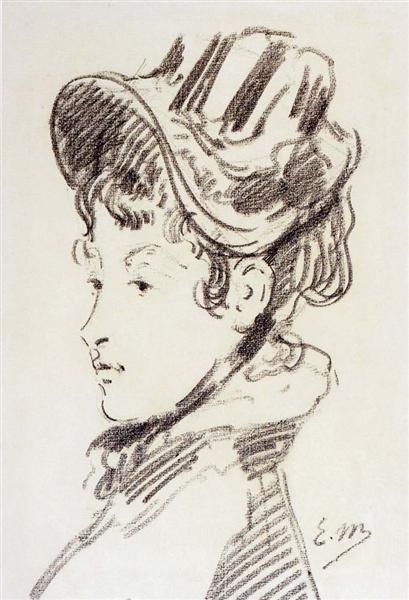Descrição
Édouard Manet, one of the most iconic figures of modern art and a precursor of Impressionism, managed to capture in his 1878 Portrait of Madame Julles Guillemet a synthetic and moving interpretation of the female figure that goes beyond a simple portrait. The work, which depicts Madame Julles Guillemet, wife of his friend and art critic Jules Guillemet, displays an authority and serenity that invites contemplation.
From the first glance, one can perceive Manet's mastery in the use of colour and light. The figure of Madame Guillemet is dressed in an elegant black dress, whose tone and texture contrast with the more subtle and dark background, composed of nuances that create softness and depth. This background does not compete with the main figure, but rather highlights her almost ethereal presence, offering a balance between the human figure and the space in which it is situated. The choice of black for the dress, in addition to being a sophisticated choice, suggests a sense of modernity and detachment, moving away from the excessive ornamentation that characterised more traditional portraits.
The details of the woman's face and hands are treated with a realism that contrasts with the simplification of her clothing. Manet uses loose brushstrokes and an expressionist treatment that, although precise, retains a certain spontaneity. Madame Guillemet's gaze, a mixture of detachment and curiosity, connects with the viewer in an intimate way, leading him to reflect on the character of the woman portrayed and, potentially, on the limitations imposed on the female figure in the society of the time.
The composition maintains a vertical layout, emphasizing the woman's dignity and bearing. Manet was known for his boldness in breaking conventions and in this painting we can see how he reaffirms the characteristics of classical portraiture, infusing them with his contemporary style. This characteristic is especially evident in the way the artist employs muted tones and a somewhat reserved palette, suggesting an introspection that challenges the more structured allegorical representations present in the academic painting of his time.
It is interesting to note that Manet was often inspired by the social and cultural reality that surrounded him. "Portrait of Madame Julles Guillemet" is not only a study of the female figure, but also a commentary on the condition of women in 19th century Parisian society, a recurring theme in his work. Through the figure of Madame Guillemet, Manet not only offers a portrait, but delves into the realm of representation and, therefore, into the social identity of women, suggesting a voice that, although silent, has the power to resonate through the canvas.
In the evolution of female portraiture in painting, Manet's work occupies a prominent place, situated between the realists and the impressionists. His style introduces modernity into the representation of the individual, which would be fundamental for later movements. Thus, this work is not only a tribute to a woman within her social context, but also stands as a milestone in the development of art in the 19th century, anchoring the female figure within a broader discourse on identity and representation in art. In short, the "Portrait of Madame Julles Guillemet" is a testament not only to Manet's technical skill, but to his ability to capture the essence of the human being, turning the everyday into the exceptional.
KUADROS ©, a famous painting on your wall.
Hand-made oil painting reproductions, with the quality of professional artists and the distinctive seal of KUADROS ©.
Painting reproduction service with satisfaction guarantee. If you are not completely satisfied with the replica of your painting, we will refund 100% of your money.

